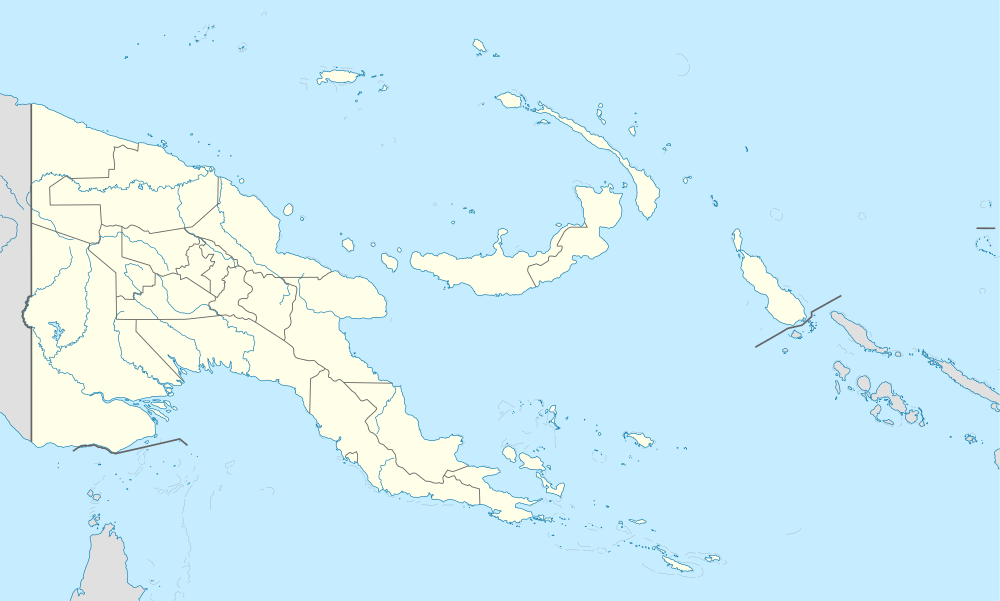Sangara, Papua New Guinea
Sangara is a settlement in south-eastern Papua New Guinea. It is located to the east of Kokoda.
Sangara | |
|---|---|
 Sangara Location within Papua New Guinea | |
| Coordinates: 8°49′23″S 148°6′7″E | |
| Country | Papua New Guinea |
| Province | Oro (Northern) |
| District | Sohe District |
| LLG | Higatura Rural LLG |
| Time zone | UTC+10 (AEST) |
| Climate | Af |
History
During the Second World War the area saw fighting between the Japanese forces and the allies (primarily Australians). Missionaries were once active in the area and a mission station was established in Sangara.[1][2] In 1948, Martyrs Memorial School for boys was established in Sangara, named in honour of 11 Anglican missionaries.[3]
Economy
The Sangara also constitute a tribe in the area. They are known for setting up markets along the road to Buna Bay to Yodda Goldfield and trading taro with tobacco and glass bottles.[4]
Sangara is a notable area of coffee production, lying in the foothills.[5] 18 commercial coffee plantations were established in 1926, paving the way for commercial production from 1928.[6] Louis Austen, a retired sea-captain, once managed a government coffee plantation near Sangara.[1] Historically there were also major rubber plantations in the area; the rubber was transported to the port at Buna Bay and then shipped overseas.[7][8] Sangara was also an important location for the sugar industry in the country. In 1928 a group of Cairns-based investors founded the Sangara Sugar Estates, Ltd., and proposed the payment of capital worth £500,000 to promote sugar production in Papua New Guinea.[9] The company was reported to have applied for some 8100 hectares of land.[6] The sugar industry in Sangara though was reportedly not as successful as the rubber industry and some of the plantations were later converted to produce rubber.[10]
See also
References
- Aerts, Theo (1994). The martyrs of Papua New Guinea: 333 missionary lives lost during World War II. University of Papua New Guinea Press. ISBN 9980-84-053-6.
- Tomkins, Dorothea, Hughes, Brian (1969). The road from Gona. Angus and Robertson.CS1 maint: multiple names: authors list (link)
- Barker, John (2008). Ancestral Lines: The Maisin of Papua New Guinea and the Fate of the Rainforest. University of Toronto Press. p. 33. ISBN 1-4426-0105-1.
- Murray, John Hubert (2009). Papua Or British New Guinea. READ BOOKS. p. 105. ISBN 1-4446-7727-6.
- Mair, Lucy Philip (1970). Australia in New Guinea. Melbourne University Press.
- Denoon, Donald, Snowden, Catherine (1980). A History of agriculture in Papua New Guinea: a time to plant and a time to uproot. Papua New Guinea. Dept. of Primary Industry. Institute of Papua New Guinea Studies.CS1 maint: multiple names: authors list (link)
- Pacific Publication (Aust.) Pty. Ltd (1961). The handbook of Papua and New Guinea.
- "A Chronology of Tramways and Railways in Papua New Guinea" (PDF). www.pngbuai.com.
- International Sugar Journal (1931)
- Lewis, David Charles (1996). The plantation dream: developing British New Guinea and Papua 1884-1942. The Journal of Pacific History. ISBN 0-9595477-8-9.